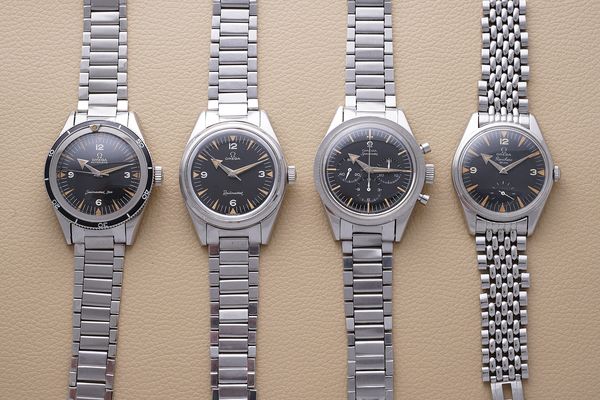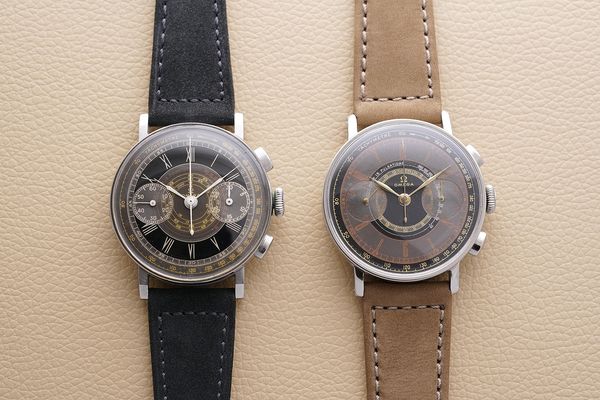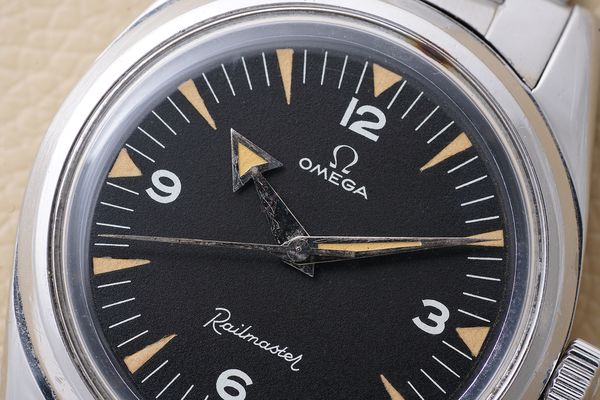- By Arthur Touchot
It’s difficult to pinpoint exactly when Omega started working on their famous "Broad Arrow" collection but a good place to start, and this is so often the case with man made objects, is several years before the company's watchmakers even began to think about making them.
The 1940s nearly spelled the end for the Swiss watchmaking industry. Several companies were left in an extremely precarious situation at the end of the Second World War. Years of devastating conflict throughout Europe meant that for many, production numbers were at an all-time low. At Omega, exports fell from 23,9 million watches in 1937, to 11.8 million in 1944, but it could have been much worse, had it not been for the large orders the company received for military watches.
Omega was an important supplier of the British Ministry of Defense, but the company also sold watches to other forces around the world. In fact, the company’s main focus during that time became improving existing watches and making them even more robust in order to equip soldiers conducting air, sea and land operations. Omega’s position, though weakened by the war, remained much more favourable than other watchmakers’ and this meant it would recover quickly during peacetime.
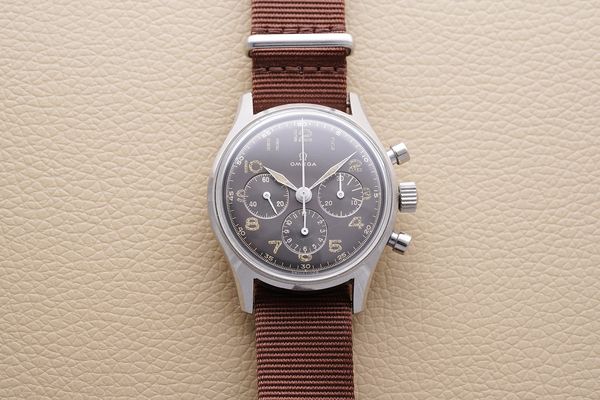
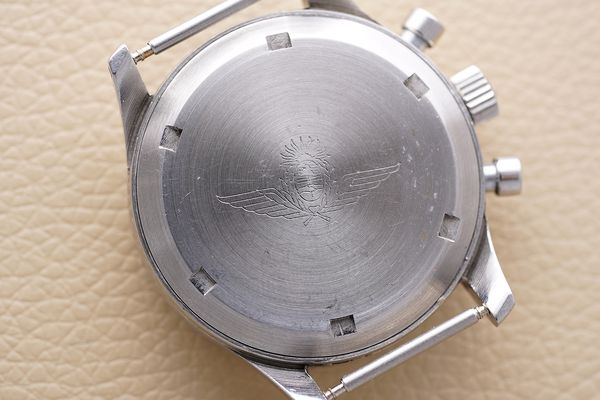
What followed was perhaps the most transformative decade for the company, and leads to one of the most important launches of the 20th century.
Thanks to relaxed trade deals with the United States, the demand for automatic wristwatches in particular exploded, and Omega’s strength in this field provided a welcome and much needed boost to its production. Sales of Omega watches quickly caught up to pre-war figures, reaching 18 million by the end of 1945, and the company soon found itself in a position of market leadership again, a position it would defend expertly through aggressive advertising campaigns.
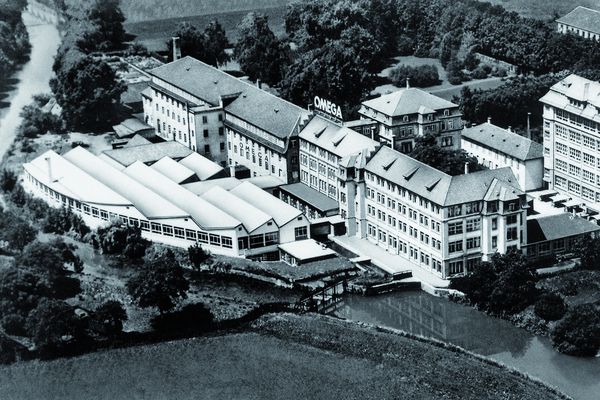
Following the celebration of the company’s Centenary in 1948, Omega’s management decided to invest CHF 20 million into new manufacturing sites to increase its production capacities, and began shifting its focus towards the booming ‘professional’ market, for which it would create three of the most important models.
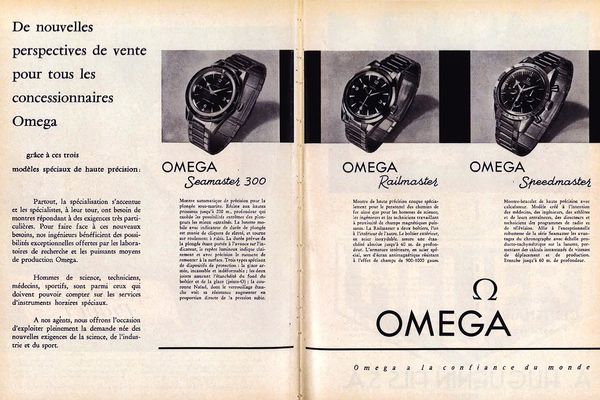
Known today by collectors as “The Holy Trinity”, the Seamaster 300 (ref. CK 2913), Railmaster (ref. CK2914), and the Speedmaster (ref. CK2915) meant that Omega could challenge close rivals for one of the fastest growing segments of the watch market.
Launched together in 1957, the three watches shared obvious similarities in terms of styling, but each was meant to provide a unique solution to problems faced by specialists in different sectors of industry.
Presented as the ideal chronograph for motorsports enthusiasts, the Speedmaster would become the best known of the three models. Designed to measure eased lap times and speed, the Speedmaster was robust, precise, easy to manipulate and read, but it was the novel position of the tachymeter on the bezel that really set it apart from other chronographs on the market.
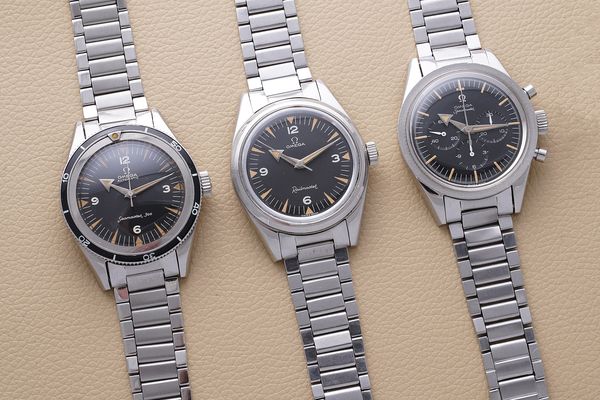
Alongside the Speedmaster, Omega launched two more stainless steel sports models, the Seamaster 300 and the Railmaster. Unlike the Speedmaster, which was, more than anything else, an exercise in intelligent design, the other models introduced some of the Omega's latest technical developments.
Professional divers, received the Seamaster 300, a new automatic wristwatch with a mobile bezel and an impressive depth rating of 660 feet thanks to its unique construction, while the scientific community got a new, highly capable antimagnetic wristwatch with the Railmaster.
Many important tool watches were already on the market when Omega’s line was introduced, including the world’s first diving wristwatch, but whilst most watchmakers presented their products sequentially, as their teams found new solutions and developed better products, Omega chose to produce a single, cohesive line-up for the 1957 edition of the Basel Watch Fair.
Why management decided to present the watches at the same time, and whether it was even planned that way or simply coincidence remains somewhat of a mystery. However, it stands to reason that Omega wanted to take full advantage of the fair’s international reach to present their latest range.
The manufacture was extremely well-prepared for the launch, having previously made military grade watches for the air, land and sea according to much stricter requirements. And that’s exactly how they would present their new watches.
The Seamaster 300 was the watch for the Sea, the Railmaster, the watch for Land, and the Speedmaster, the watch for everything else – conceived as a motorsports watch, this particular model actually became known for its exploits in the Air.
For many years after their launch, elegant, gold chronometers remained at the forefront of Omega’s production, but the enduring popularity of the professional watches and their presence during major events of the 20th meant they would become absolute icons of watchmaking.
The Speedmaster’s famous inclusion in the Apollo program at the end of the 1960s surely makes it the most significant chronograph ever built, while the Seamaster’s underwater capabilities continued to improve massively, inspiring many other divers to adopt some of its most innovative features.
But what makes “The Holy Trinity” truly great and collectible today is the singularity of their design. Since they were conceived by one team, the watches share many traits, including robust cases, thick lugs, similar dials and hand styles, and flat-link bracelets.
While their market values are very different these days, the watches themselves remain equally difficult to find in great, original condition - since the majority of the watches were actually worn and used by the people who bought them - and that makes the challenge of collecting them extremely worthwhile in the eyes of important collectors.
In fact, the interest for these watches is so high that last year, Omega chose to release identical, modern copies of the three watches to celebrate their 60th anniversary. The new models look exactly the same as the original trilogy, down to the proportions of the cases and the faux vintage lume.
Looking back, it is clear the original Seamaster 300, Railmaster, and Speedmaster form one of the most successful product launches of the 20th century. It is a therefore a real privilege for us to present a complete set of the "Broad Arrow" family in spectacular condition during our next auction - The Geneva Watch Auction: EIGHT.
Below, we'll explain what makes each one special in their own right. These are, in our humble opinion, some of the finest original examples we have ever witnessed come to auction, and we are pleased to present them reunited.
The Seamaster CK 2913
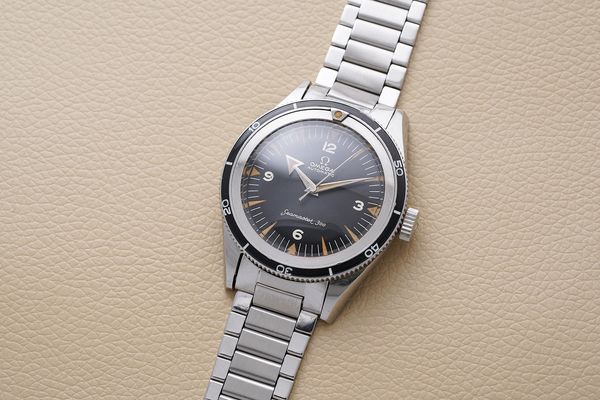
While not new to Omega’s catalogue, the Seamaster name found its true meaning with the launch of the reference CK 2913, the company’s first true professional diver’s wristwatch. Thanks to its robust case with screw-on back and integrated O-ring gasket as well as its very thick and pliable glass, this was the first Omega with a guaranteed water resistance of 200 meters or 660 feet. The watch was tested and could withstand higher pressures, hence the decision to ultimately name it the Seamaster 300.
The latest Seasmater meant Omega could compete with its main rivals for the fast growing diving market. First generation Seamaster 300 like the present watch were fitted with a rotating bezel divided in 10-minute intervals to show elapsed time, or calculate decompression stages.
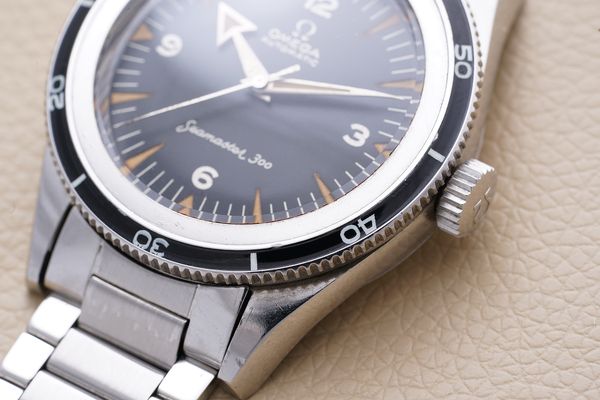
Among the new collection, the Seamaster 300 in particular demonstrated the innovation, creativity and modernity of the Swiss manufacture. Unlike other watches that claimed water resistance, Omega’s latest Seamaster presented a glass that was screwed-in from the inside, meaning the watch could survive decompression after saturation diving, even without a helium valve, a detail that came to professional divers’ watches only years later.

Powered by an automatic movement, Omega’s diver and its large luminescent hands was extremely well received by professionals, and would later be selected by Britain’s Royal Navy for issue to its divers. Military versions of the Seamaster 300 are extremely collectible today, but ask Omega collectors and they will say the original “Broad Arrow” Seamaster is still the one to have.

The perfectly patinated dial and broad arrow hands of the present Railmaster make this particular example one of the finest we’ve ever laid eyes on. Made in 1959 and delivered in Sweden, it has not aged a day and remains as it was when it left Omega’s workshops.
The Railmaster CK 2914

While it was never going to be as popular as the Speedmaster or the Seamaster - the watch fills a much smaller but no less technical niche - the Railmaster is an extremely impressive watch in what it does, or more importantly, what it protects against.
Thanks to a newly developed case construction, featuring an inner soft iron cage, Omega's Railmaster could withstand magnetic fields up to 1000 gauss, and that meant the company could compete with the likes of Rolex, IWC and Patek Philippe for a slice of the scientific community, a growing market for watches.

At the time of its launch, the Railmaster was Omega’s most advanced anti-magnetic wristwatch. Omega had made antimagnetic wristwatches in the past, with notable results as early as the 1920s, but the Railmaster and its calibre 30 SC-285 presented the first significant, and scalable improvement.
To protect its movement, from the damaging effects of those magnetic ‘fields’ Omega developed a soft iron inner case. Acting like a Faraday case, this two-part case construction proved to be a very adequate solution and the Railmaster and its caliber 284 with small seconds placed at 6 o’clock performed well.
Volume was important to Omega. More and more homes were being equipped with electrical outlets generating important electromagnetic fields, and the potential for a much larger market was certainly there. However, the demand for antimagnetic watches meant the model would fall behind the Seamaster and Speedmaster in terms of sales.
Still, the Railmaster’s design with its explorer-style dial makes it one of the most appealing vintage wristwatches. In fact, it’s hard to think of a better looking time-only watch, and this one happens to be one of the more technically interesting pieces.
Great examples are difficult to find, but the prices appear extremely reasonable and it remains the most accessible watch of the “Holy Trinity”. If you’re into the overall aesthetic of these watches, this is the one that offers the best value.
The Speedmaster CK 2915
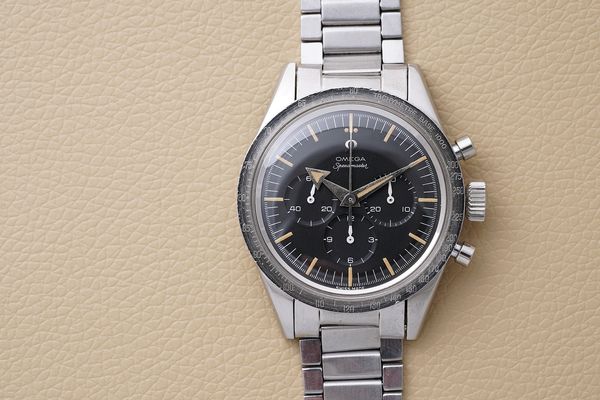
While the Seamaster and the Railmaster were introduced as direct competitors to existing wristwatches, the Speedmaster was a real surprise when it came out in 1957. Few manufacturers made chronographs the way Omega made the Speedmaster, as a robust and relatively cheap watch – in many ways, this was the first chronograph to exist outside of its intended niche, motorsports.
In terms of design, the Speedmaster stood out as the first chronograph to feature a tachometer scale (or, as Omega called it at the time, the Tacho-productometer scale) on the bezel, rather than on the dial.
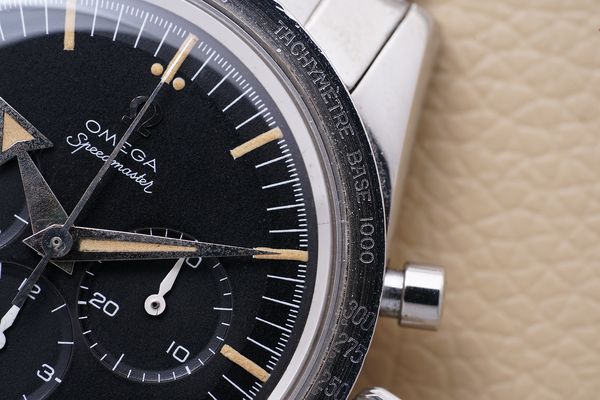
This made the dial much cleaner and therefore easier to read, and Omega believed it would allow wearers to quickly reference the scale for measuring speed. The new design proved very popular and other manufacturers would soon follow Omega’s example, but it is important to remember the Speedmaster initiated that particular aesthetic.
In terms of movements, Omega did not go for a brand new caliber, turning instead to caliber 321, an extremely reputable and reliable column-wheel chronograph, which it recognized as the best available option for its new Speedmaster. Together with the novelty of its tachymeter bezel, the watch was undoubtedly the best chronograph on the market.
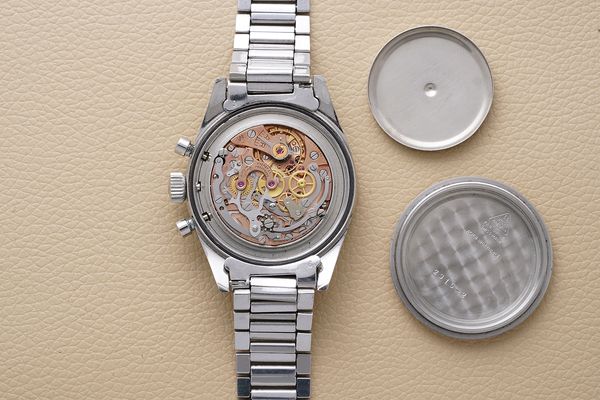
What made it special, beyond the intelligence of the new design and the quality of its movement was the toughness of the watch. The watch was as close to unbreakable as Omega could make it. It was anti-magnetic, shock-proof, and waterproof up to 60 meters, qualities that would remain the foundation for all subsequent Speedmasters.
The Speedmaster line features a remarkable evolution, spans sixty years and a variety of dial, bezel, hand and bracelet variations, but the first model, reference CK 2915, is considered by collectors as “the grail” for a couple of reasons.
First and foremost is the model’s historical importance. This is not only the first Speedmaster, but it is the first chronograph with tachymeter scale on the bezel - a design choice that most manufacturers, including Rolex, would take inspiration from.
Second, it is the rarest Speedmaster. The production of CK 2915 lasted only two years, between 1957 and 1959, before its replacement, reference CK 2998, was introduced. And that makes first generation “Broad Arrow” Speedmasters particularly desirable.
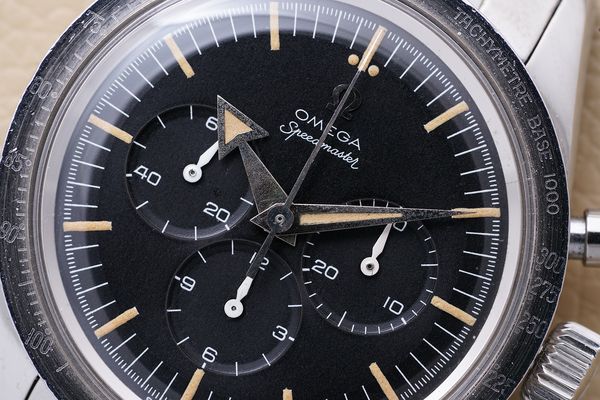
Many simply consider it the most appealing, aesthetically-speaking. Since these first generation models are 60 years old, some examples have so-called tropical dials. Whether or not these are more desirable is a matter of personal opinion, but the unspoiled matt black dial of the present reference 2915-2 is a much rarer sight.
The present example, from 1959, shows absolutely no such sign of aging. Instead, it displays a perfect matt black dial and full, even lume. A reference 2915-2, the present watch, displays all correct features from the second generation of the reference. The first is the 'Base 1000' bezel, followed by the dial configuration. The Omega signature features the iconic 'fat' O followed by the slightly longer 'r' in the Speedmaster signature.
Other examples have instead developped a "tropical" patina over time, such as the reference 2915-1 shown below. Some collectors go absolutely mad for these rare examples. It's important to note that not all tropical dial look the same. They vary in every way possible, in shade and in uniformity.

The Reference 2915-1 seen here is one of the remarkable "tropical" examples. Its dial has aged to a vibrant milk-chocolate shade, which is both very unusual and very attractive. Very few watches age this way.
The Ranchero CK 2990 aka “The Fourth Musketeer"

Also known as the “Fourth Musketeer,” due to its resemblance to the Speedmaster, Railmaster, and Seamaster 300, the Omega Ranchero was released as a standalone piece in 1958.
Meant as an entry-level alternative to the professional models, the Ranchero was styled after these watches, utilizing the same configuration of black dial, triangle-shaped luminous markers, and broad arrow hands.
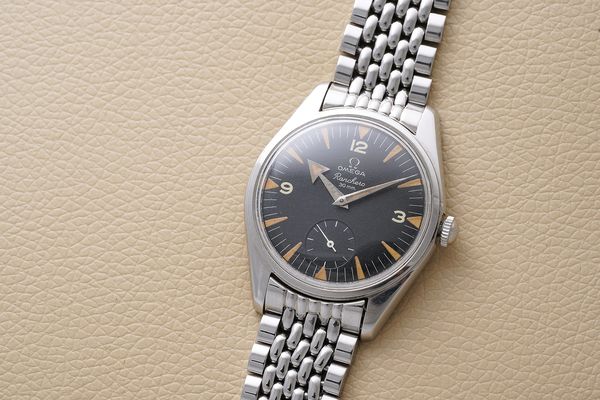
Despite presenting a compelling product – the Ranchero was thinner but just as weatherproof as its contemporaries – Omega couldn’t properly market the watch and the model was phased out of production shortly after its launch, making the Ranchero the rarest of the four watches.
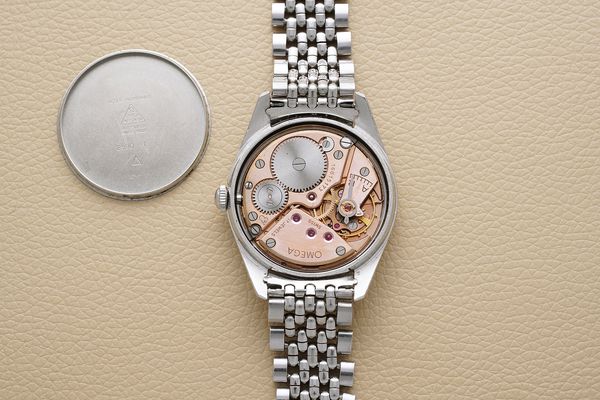
The challenge of finding one in pristine condition – such as the present example – is just as great, if not greater, as it is with other “Broad Arrows” and to some that makes it the most desirable out of all.
The watches included in the article above will all be available in the upcoming Geneva Watch Auction: EIGHT, except for the Omega Ref. 2846, which was sold by Phillips in 2017, during the Geneva Watch Auction: FIVE.
Phillips would like to thank Petros Protopapas and the Omega Museum afor their invaluable research on the present lots.
